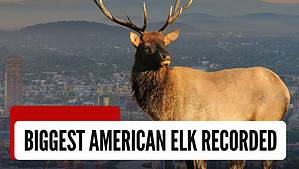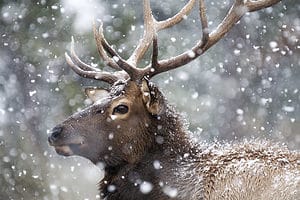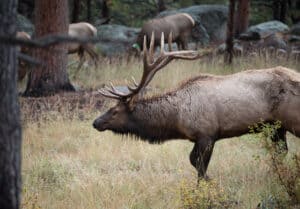One of the largest members of the deer family is the elk. They are very similar to deer when it comes to their tracks & and signs. However, elks have larger hooves, scat, and longer strides. Besides their tracks, elk have other signs of existence. For example, feeding signs and antler rubs high up on trees. But, if you do come upon some large tracks in the mud or snow, this is hard to determine whether they are elk tracks.
Elk Tracks
| Size | Shape |
|---|---|
| Front Track 4-4.5 inches in length The front of the track is 3-4 inches | Two toes on each foot |
| Rear Track Approximately 3.5 inches long 3 inches wide | Elk tracks make deeper impressions due to their massive weight |
| Tracks and dewclaw marks become very obvious when running. | |
| Round in shape |
Elks have an alternating walk pattern and a step length of 1.5 to three feet. Furthermore, they have a trail width of 7 to 13 inches. However, it is rare to find a lovely clear pattern made by one elk as they travel in groups. Therefore, the prints they leave are usually a mess of tracks left by multiple animals.
Elk Tracks in the Snow
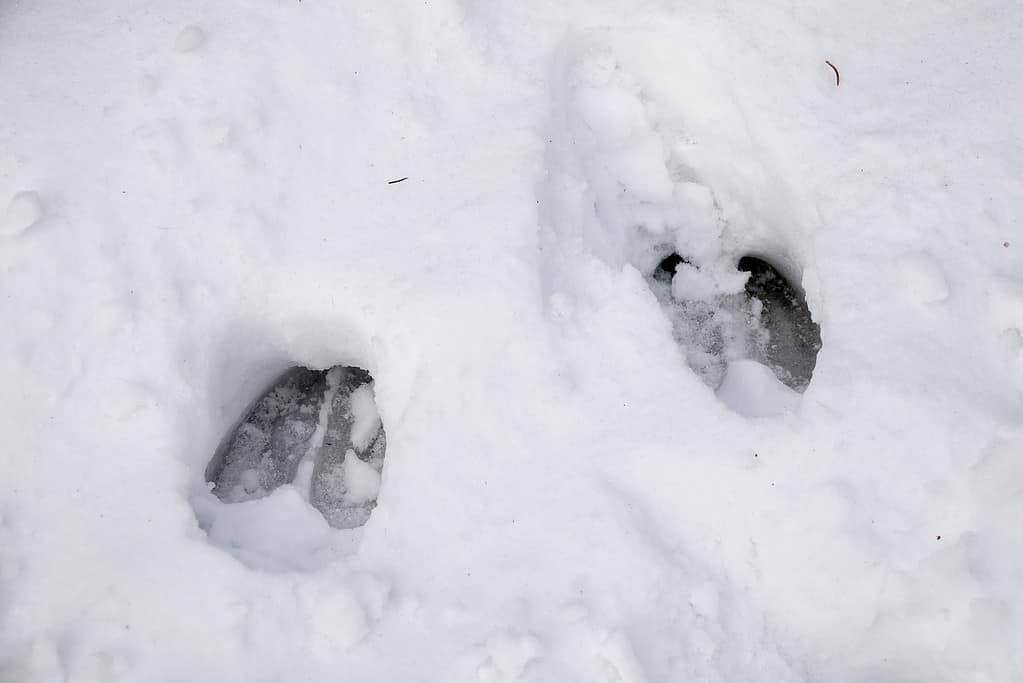
Here are perfect impressions of elk tracks in the snow.
©iStock.com/Björn Forenius
- Adult elks measure 4.7 to 6.2 inches long, and the tracks of the forefeet have visible hoof prints.
- The hind print is usually situated on the forefoot track or just a bit behind it. There is typically a double line in the snow with hoof tips.
- When walking calmly, their strides are 3.3 feet
- At a gallop, their strides are 9.8 feet
- They create a plow furrow because they don’t lift their feet in deep snow
Elk Tracks in the Mud
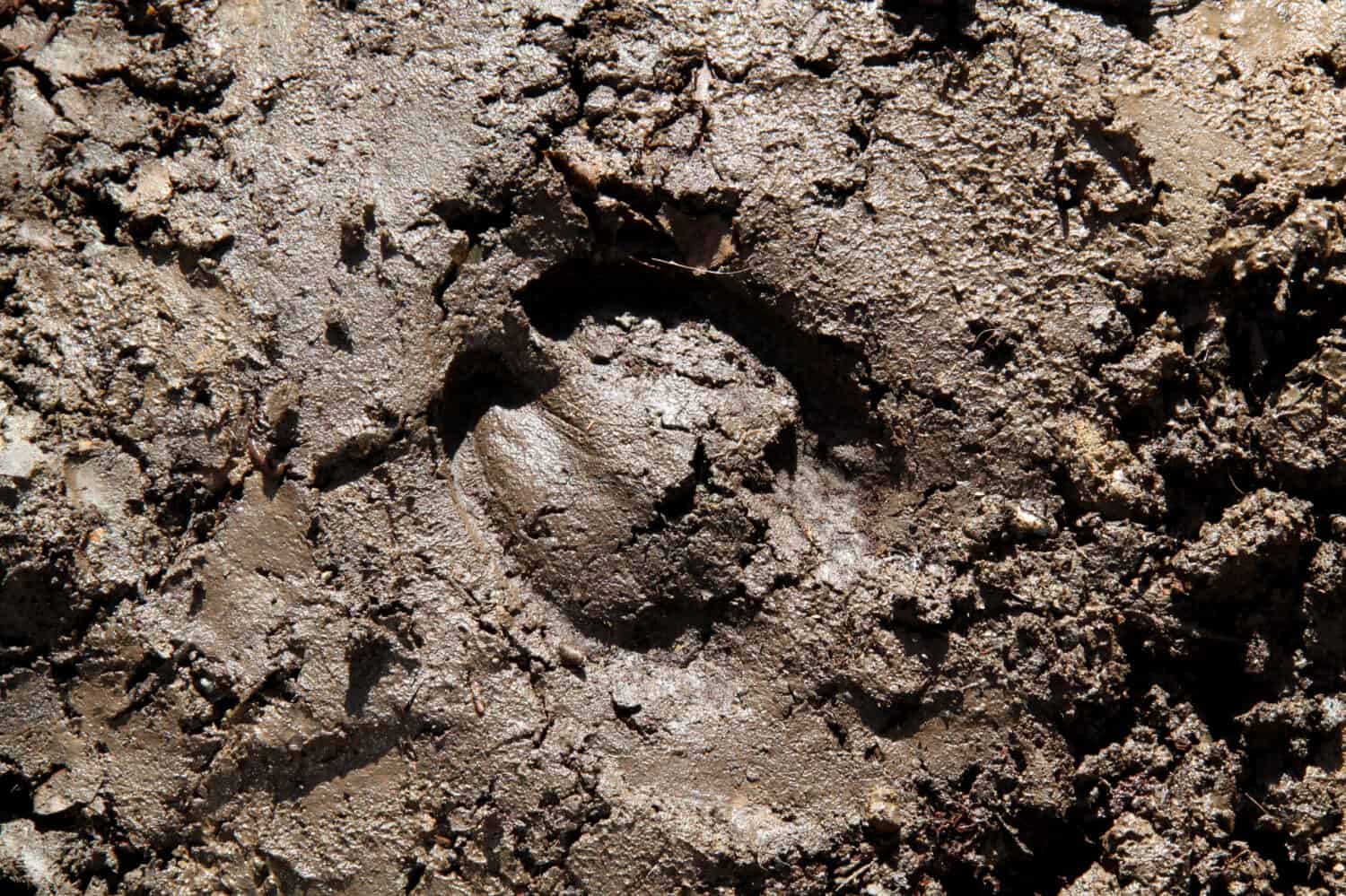
Elk tracks in mud should be around four inches or longer in length.
©Jerry-Rainey/Shutterstock.com
In order to ensure you are looking at an elk track in the mud, measure it. Their prints should be around four inches or longer in length. If they are any smaller, it’s more than likely deer tracks. However, if they are longer than five inches, there is a good possibility they are moose tracks.
The best way to identify an elk’s tracks is by looking at the shape of the track’s edges. Compared to moose or deer prints, elk tracks are more rounded. In addition, the spacing between the toes is also a good way to identify elk tracks. For example, if the gap between the toes is further apart at the tip than in the center, it is more than likely an elk track. Cattle, moose, and deer all have even gaps between their toes.
Other Ways to Identify Elks
Tracks are a good way to identify elks, but other signs also reveal their presence. They include:
Scat
Elk scat is a ¾ by ½ inch pellet. When they feed on dry forage in the winter, it results in discrete pellets. However, when they consume lush vegetation, their scat turns into clumped pellets or pies.
Rutting Sign
There is a short time frame from September to October when elk rut. This is when bulls rub and thrash their foreheads and antlers on shrubs and trees. As a result, they leave behind stripped bark, broken branches, and on occasion, hair. Additionally, elk also leave their scent behind, which is a form of communication. They are particularly fond of conifer saplings. Rutting signs are typically two to five feet above the ground. Furthermore, bulls also burn up the mud with their hooves, creating wallows.
Feeding Sign
You need to know their diet when identifying elks by their feeding sign. Elks consume sedges, grasses, aquatic plants, forbs, tree leaves, and shrubs like willows, aspens, chokeberries, and serviceberries in the warmer months. However, elks paw through the snow in the colder months to find food like grass, twigs, and bark.
So, when looking for their feeding signs, keep an eye out for ragged ends. Because elk don’t have upper incisors, they cannot bite through plants with a clean cut like rabbits or rodents can. Elk use their lower incisors and upper pallet to tear vegetation, which leaves frayed edges. In addition, they use their lower incisors to scrape bark upward, free it from the tree, which leaves frayed bark at the upper end.
Another factor to look at is the height of the feeding sign. Deer typically feed one to three feet above the ground. Furthermore, moose leave signs three to seven feet off the ground.
Animal Tracks That Look Similar to Elk Tracks
There are a few animal footprints that people may confuse with elk tracks. They include:
Deer Tracks
Many describe deer tracks as heart-shaped. Their tracks are thick at the bottom and narrower near the tip. Sometimes their tracks have two declaw marks on the back of each foot. These markings are usually present when the deer runs. In addition, their tracks differ in size. For example, several hoofed animals make smaller tracks with their hind legs and larger tracks with their front legs.
Deer tracks are generally between 1.25 to 4 inches long and between 1.75 to 2.75 inches wide. Deer tracks look incredibly similar to elk tracks. But, the biggest determining factor between the two is their size. Elk tracks are bigger, measuring between 4 to 5 inches long and three to four inches wide. However, it is much harder to tell them apart if large deer species live in the same area. The top of the elk’s track doesn’t taper as much, meaning they leave a clearer impression in the deep ground due to their weight. Furthermore, if elk run, their footprint and dewclaw markings become obvious and large.
Moose Tracks
Since moose can weigh over 100 pounds, their tracks are quite large. They measure between 4.5 to 6 inches long and around five inches wide. Their heart-shaped tracks have a noticeable inward curve and get narrower near the tip. In addition, moose tracks usually have dewclaw markings on the back of the print. While there is a significant size difference between a moose track and a deer track. It might be harder to differentiate between an elk track and a moose print as they are similar in size.
Cattle Tracks
It is common for cattle and elk to occupy the same areas. Therefore, it is important to be able to differentiate between the two. The most distinguishable difference between the two footprints is their size. Cattle have much larger hoofs than elk, so their tracks are significantly bigger. One sure-fire way of differentiating between the two is if there are dewclaw impressions, as cattle don’t have dewclaws, whereas elk have dewclaws on each foot. They leave imprints when the elk runs or walks through deep snow, dirt, or mud. However, the shape of the two tracks is noticeably different. Cattle tracks are rounder, while elk tracks are elongated. Therefore, just looking at the shape of the track, you can easily identify which animal it belongs to.
Age and location also factor in when it comes to differentiating between the two animals’ tracks. For example, cattle prefer meadows and wide open spaces where they have plenty of space to roam. Elks, on the other hand, prefer steep canyons and thick forests, which cattle tend to avoid. However, elk do sometimes graze in open spaces. Therefore, if you are in a dense forest and happen to come across large two-toed tracks, they probably belong to an elk.
Conclusion
Elk tracks are best distinguished by their size and shape. The quickest way to tell if you are, in fact, looking at an elk track is by studying the gap between their toes. If it is wider at the tip and becomes narrower at the center, it likely belongs to an elk.
Thank you for reading! Have some feedback for us? Contact the AZ Animals editorial team.




